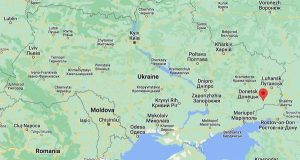
Ukraine – Drones Turn Off Electricity
MOON OF ALABAMA
In early September Gallup did a survey in Ukraine:
More than six months into a war that many around the world (including Russia) thought Ukraine would lose quickly, most Ukrainians are resolved to keep fighting. A clear majority — 70% of all Ukrainians interviewed in early September — say their country should continue fighting until it wins the war with Russia. Just over one in four (26%) favor negotiating to end it as soon as possible.
That 70% poll number is likely the high point as it came at a time that promised Ukrainian successes.
The situation for Ukraine has since gotten worse. Much worse.
Since mid September the Ukrainian counter offensive east of Kharkov (north-east) has come to a halt. Despite serious Ukrainian losses the counter offensive in the southern Kherson (south-central) direction has likewise not moved a lot. Both of these front lines are now stable. On the Donbas front (east) the central Ukrainian position in Bakhmut (Artyomovsk in Russian) is in danger of being overrun.

Russia has mobilized some 220,000 reservists and some 70,000 volunteers. These are now in training and by next month, most of them will be able to join the fight. The weather in recent weeks has become more rainy. Tanks and trucks can no longer move over open fields without risking to get stuck. In late November/December frost will set in. The ground will freeze and Russia will be able to launch large attacks.
Russia has also changed the war’s rhythm. While it had so far refrained from hitting civilian infrastructure, aside from electrical transformer stations serving the railroad network, it has now launched attacks on thermal power stations and Ukraine’s 330 kilovolt long range electrical distribution network.

bigger
The Russian attacks are effective:
From towns near frontline battlefields to high-rises in the capital, Ukrainians were trying to conserve energy as President Volodymyr Zelensky warned on Tuesday that Russian attacks over the past eight days had destroyed 30 percent of Ukraine’s power stations and caused “massive blackouts across the country.” The latest strikes have increased the likelihood of a miserable winter, with residents having to do without basic services such as heat and water.
…
Mr. Zelensky urged Ukrainians in his nightly address on Monday to reduce their electricity use during peak hours to “enable the whole country to go through this period more stably,” and many residents and businesses have been doing their part.In his statement on Tuesday, he did not specify which power stations had sustained significant damage. On Tuesday, blasts hit a district on the eastern shore of the Dnipro River in Kyiv, Ukraine’s capital, according to the mayor, along with cities in the north and center of the country.
The attack on Kyiv killed three people and knocked out electricity and water in parts of the city, officials said, and came one day after Russia struck the city with exploding Iranian-made drones, apparently targeting electricity and heating facilities.
In Kyiv, lights flickered just after 9 a.m., and residents living in the city’s eastern reaches said they had heard an explosion. The mayor, Vitaly Klitschko, said that an “object of critical infrastructure” had been struck. Kyrylo Tymoshenko, a senior official in Mr. Zelensky’s office, said that at least three strikes had hit an energy site, resulting in “serious damage,” without elaborating.
The USSR left Ukraine with a very decent electricity network and substantial generation capacities.

bigger

bigger
- To turn off all thermal (coal, gas) power plants in Ukraine.
- To destroy those switching stations where more than two 330k lines connect.
This will cut the generation capacity in Ukraine by half and totally disconnect some regions, especially in the east, from any generation capacity.
It will thereby darken the cities in eastern Ukraine, which will make waging war more difficult for the Ukrainian military. It will also make it more difficult for material support like weapons and ammunition to reach the front lines. (The regions that were integrated into Russia receive electricity from Russia.)
The attacks on the Ukrainian electricity network will have some external effects. Throughout the last years Ukraine supplied surplus electricity to some of its neighbors. Moldavia and Hungary were the two biggest buyers of Ukrainian electricity. While Hungary is connected to the wider European network, Moldova is not. It also has only 350 megawatt of generation capacity. In 2017 some 20% of its energy came from Ukraine. Should one of its own power plants fail or need maintenance it will likely see blackouts.

bigger
Wars come at a cost. Last month, most Ukrainians had yet to personally feel that. That will now change.
A survey in Ukraine held in spring 2023 will likely show the opposite result of the one held in early September.
Russia has ordered more drones and missiles from Iran. Where it will put those to use is likely not yet decided. If Ukraine thinks of another provocation, like the recent Kerch bridge attack, it should better consider the consequences.
************
Source

••••
The Liberty Beacon Project is now expanding at a near exponential rate, and for this we are grateful and excited! But we must also be practical. For 7 years we have not asked for any donations, and have built this project with our own funds as we grew. We are now experiencing ever increasing growing pains due to the large number of websites and projects we represent. So we have just installed donation buttons on our websites and ask that you consider this when you visit them. Nothing is too small. We thank you for all your support and your considerations … (TLB)
••••
Comment Policy: As a privately owned web site, we reserve the right to remove comments that contain spam, advertising, vulgarity, threats of violence, racism, or personal/abusive attacks on other users. This also applies to trolling, the use of more than one alias, or just intentional mischief. Enforcement of this policy is at the discretion of this websites administrators. Repeat offenders may be blocked or permanently banned without prior warning.
••••
Disclaimer: TLB websites contain copyrighted material the use of which has not always been specifically authorized by the copyright owner. We are making such material available to our readers under the provisions of “fair use” in an effort to advance a better understanding of political, health, economic and social issues. The material on this site is distributed without profit to those who have expressed a prior interest in receiving it for research and educational purposes. If you wish to use copyrighted material for purposes other than “fair use” you must request permission from the copyright owner.
••••
Disclaimer: The information and opinions shared are for informational purposes only including, but not limited to, text, graphics, images and other material are not intended as medical advice or instruction. Nothing mentioned is intended to be a substitute for professional medical advice, diagnosis or treatment.





Leave a Reply